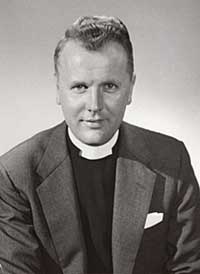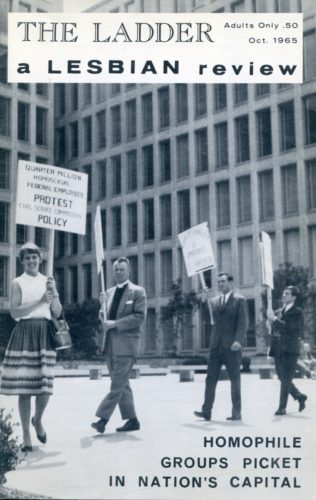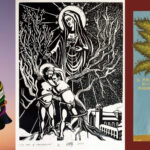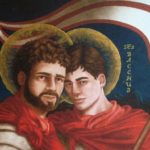Last Updated on August 18, 2024 by Kittredge Cherry

Robert Watson Wood was an ordained Congregational minister who started advocating for LGBTQ rights in the early 1960s. He died Aug. 19, 2018, at age 95.
In 1960 Wood urged churches to welcome lesbian and gay people in America’s first book on homosexuality and Christianity, “Christ and the Homosexual.” He went on become the first member of the clergy to picket for LGBTQ rights, wearing his clergy collar at 1965 protests. His advocacy for LGBTQ rights continued throughout his long life, although he was so far ahead of his time that his contributions have been forgotten by many.

Rev. Robert Wood and others are shown picketing for LGBTQ rights in 1965 on the cover of The Ladder.
Wood can clearly be seen picketing in his clergy collar on the cover of the October issue of “The Ladder,” the first national lesbian publication in the United States. The headline says, “Homophile groups picket in nation’s capital.” The photo credit on page 3 adds, “Front cover photo by Eva. Taken at the picketing at Civil Service Commission Building, Washington, DC, on June 26, 1965. This picture shows four of the 18 men and 7 women who took part in the march to protest the Civil Service Commission’s policies on homosexuals.” One of the protest signs reads, “Quarter million homosexual federal employees protest Civil Service Commission policy.”
A memorial service will be held Oct. 2 at Havenwood-Heritage Heights retirement community in Concord, New Hampshire, where Wood lived.
Wood wrote “Christ and the Homosexual” in 1960
 “Christ and the Homosexual” was published in 1960 under Wood’s own name with his photo on the dust jacket, even though friends and colleagues warned him that this would damage his reputation. He borrowed against his life insurance policy to finance publication of the ground-breaking book.
“Christ and the Homosexual” was published in 1960 under Wood’s own name with his photo on the dust jacket, even though friends and colleagues warned him that this would damage his reputation. He borrowed against his life insurance policy to finance publication of the ground-breaking book.
“Christ and the Homosexual” calls for the church to welcome homosexuals, recognize same-sex marriage and ordain homosexual clergy. Wood’s LGBTQ Christian message is still powerful today. As he wrote in “The Church and the Homosexual” in 1960:
The Church has done much to keep the homosexual from Christ. Society, often under the influence of the Church, has also thrown roadblocks in the pathway of the homosexual who seeks a higher purpose in life beyond the sexual plane of pleasurable existence.
But the struggle is difficult, the motives misunderstood, the behavior pattern considered perverted. Yet Jesus Christ, whose struggle was also difficult, whose motives were also misunderstood, whose behavior pattern was revolutionary, awaits all men — even the overt homosexual.
Wood draws powerful, liberating conclusions in “Christ and the Homosexual”:
The basic point is that the saving message of Christ and the freely flowing grace of God are as much for the homosexual as the heterosexual; that the Church must minister equally to both; that the demands of Christ apply to both; that both are capable of being moral, as well as immoral and amoral.
Minister Robert Wood picketed in his clergy collar
Wood wore his clergy collar while picketing in early LGBTQ rights protests every Fourth of July from 1965 to 1969 in front of Independence Hall in Philadelphia. The events were called Annual Reminders because they aimed to remind the public that “homosexual Americans” were denied the rights to “life, liberty, and the pursuit of happiness” as guaranteed in the U.S. Declaration of Independence.
Forty gay men and lesbians from Washington, D.C., Philadelphia and New York picketed at the first Annual Reminder in 1965. At the time it was the largest demonstration for LGBTQ rights in world history. From then on, the demonstrations grew bigger. The rest is history.
 Religion tends to get downplayed in LGBTQ history, but the role of Wood and other church leaders is reclaimed in “Reforming Sodom: Protestants and the Rise of Gay Rights” by religion professor Heather Rachelle White. She challenges the prevailing LGBTQ secular narrative and recovers the forgotten history of liberal Protestants’ role on both sides of the debates on sexual orientation and identity.
Religion tends to get downplayed in LGBTQ history, but the role of Wood and other church leaders is reclaimed in “Reforming Sodom: Protestants and the Rise of Gay Rights” by religion professor Heather Rachelle White. She challenges the prevailing LGBTQ secular narrative and recovers the forgotten history of liberal Protestants’ role on both sides of the debates on sexual orientation and identity.
Gay rights pioneer lived a long life
Wood was born in Youngstown, Ohio, on May 21, 1923. He grew up in Ohio and became aware of his homosexuality in high school. Although he advocated for LGBTQ rights and lived openly with his male partner, he didn’t come out publicly as gay himself until his retirement in 1986.
He was ordained in 1951 and served at the Broadway Tabernacle in Manhattan, then at parishes in Spring Valley, NY; Newark; and Maynard, MA .
In 1962 Wood met his life partner Hugh M. Coulter, an abstract artist, former rodeo cowboy and a fellow World War II veteran. They lived together as a couple while Wood served as pastor of three different parishes over the next 26 years until Coulter’s death.
More details about his life and accomplishments can be found in the following obituaries:
The Rev. Robert Wood, gay rights pioneer, was a man of God way ahead of his time (Concord Monitor)
Links related to Robert Wood
LGBTQ religious history meets Independence Day in Annual Reminder protest (Q Spirit)
Rev. Robert W. Wood (LGBT Religious Archives)
Rev. Robert W. Wood: Gay Pioneer (lgbt50.org)
“Christ and the Homosexual: An Early Manifesto for Affirming Christian Ministry to Homosexuals” by Bernard Schlager, published in “Theology & Sexuality,” volume 21, no, 2 (2015)
___
To read this article in Spanish go to:
Robert Wood: Primer clérigo que reivindicó los derechos LGBTQ, autor del primer libro sobre el cristianismo y la homosexualidad (Cristianosgays.com)
___
This post is part of the LGBTQ Saints series by Kittredge Cherry. Traditional and alternative saints, people in the Bible, LGBT and queer martyrs, authors, theologians, religious leaders, artists, deities and other figures of special interest to lesbian, gay, bisexual and transgender and queer (LGBTQ) people and our allies are covered.
This article was originally published on Q Spirit in August 2018, was expanded with new material over time, and was most recently updated on Aug. 18, 2024.
Copyright © Kittredge Cherry. All rights reserved.
Qspirit.net presents the Jesus in Love Blog on LGBTQ spirituality.























Although I did not come to the conclusions you advocated in your 1960 book until 1975… 18 years after being ordained as a “minister of The Gospel”… I might have written a similar book entitled “Christ and The Negro”… and indeed saw parallels when I came to your truth in 1975. But as I learned in later years in a more enlightened view of LGBTQ realities as I grew in solidarity… those parallels only went so far as the nature of their exclusion. ‘The Negro’ could always find refuge and support within family and the church… at least the Black church. Thank you, Robert Wood, for your courageous witness that planted seeds that enabled the liberation of many like me!
thank you Robert Wood, you and your book were a saving grace when I was first coming out in the 60’s… you words all the more important to be heard again today helped me keep my sanity and Christian faith when no other voice was heard! Thank you for your ‘lived Christian Spirit’, may you rest in God’s peace and you continue to be a ‘voice’ for us who are trying against all odds to live the Christian Catholic LBGT life!
RIP Rev.Wood now you are reunited with your godly partner.May God Bless and keep you both.!!!!